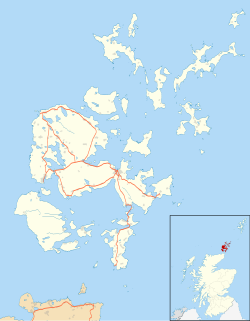59°20′53″N 2°25′08″W / 59.348129°N 2.418916°W
 Broch of Burrian, interior | |
| Location | North Ronaldsay |
|---|---|
| Coordinates | 59°20′53″N 2°25′08″W / 59.348129°N 2.418916°W |
| Type | Broch |
| History | |
| Periods | Iron Age |
The Broch of Burrian is an Iron Age broch located on North Ronaldsay in the Orkney Islands, in Scotland (grid reference HY76275138).
YouTube Encyclopedic
-
1/2Views:478893
-
Puffins on island of Westray Orkney Scotland UK Birds Wildlife
-
kirbister farm museum orkney
Transcription
Location
The Broch of Burrian is located on the southern tip of North Ronaldsay in the Orkney Islands.[1] The broch stands on a small headland next to a rocky shoreline.[2] It is separated from the hinterland by a series of defensive earthworks.[2]
Description
The broch has an external diameter of 18 metres and an internal diameter of 9.5 metres.[2] The entrance passage is on the southeast side, and the walls are solid.[1] There is a small room in the inner wall of the broch on the northeast side.[2] The broch is surrounded by outer defences consisting of the remains of four concentric ramparts on the landward side.[2]
Excavations
The Broch of Burrian was excavated by William Traill, proprietor of the island, in 1870 and 1871.[2] A large number of artefacts, including a significant quantity of worked bone objects, were discovered. In addition, a number of artefacts of early historic or Pictish date were found.[2] These include a cross-slab with ogham inscription, painted pebbles and part of an iron bell of Celtic type.[2] Part of a Pictish house was uncovered to the north east side of the broch.[2] The finds are now in the National Museum of Scotland.[1]
The evidence suggests two phases of occupation, both dating to the Iron Age. In the second phase, the broch was converted into a sort of wheelhouse. The second phase went on for a long time, as there were clear Pictish elements among the finds, from as late as the 7th to the 9th centuries AD.[2] Two items (the cross-slab and the iron bell) suggest early Christian activity, although there is as yet no other evidence for monastic settlement.[2]
References
External links
- Broch of Burrian artifacts in the National Museum of Scotland
- Historic Environment Scotland. "Burrian, broch and settlement S end of Stromness, North Ronaldsay (SM1427)".

